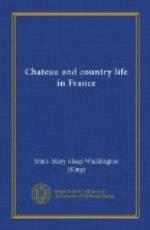The drive home was beautiful—not nearly so lonely. Peasants and fishermen were coming back from their work—women and children driving the cows home. We noticed, too, a few little, low, whitewashed cottages in the fields, almost hidden by the sand-hills, which we hadn’t seen coming out.
HARDELOT.
Hardelot was a great resource to us. It is a fine domain, beautiful pine woods running down to the sea—a great stretch of green meadow and a most picturesque old castle quite the type of the chateau-fort. The castle has now been transformed into a country club with golf-links, tennis, and well-kept lawns under big trees which give a splendid shade and are most resting to the eye after the glare of the beach. There is no view of the sea from the castle, but from the top of the towers on a fine day one just sees a quiver of light beneath the sky-line which might be the sea.
The chateau has had its history like all the old feudal castles on the sea-board and has changed hands very often, being sometimes French and sometimes English. It was strongly fortified and resisted many attacks from the English before it actually came into their possession. Part of the wall and a curious old gate-way are all that remain of the feudal days. The castle is said to have been built by Charlemagne. Henry VIII of England lived in it for some time, and the preliminaries of a treaty of peace between that monarch and Francois I were signed there—the French and English ambassadors arriving in great state—with an endless army of retainers. One wonders where they all were lodged, as the castle could never have been large—one sees that from the foundations; but I fancy habits were very simple in those days, and the suites probably slept on the floor in one of the halls with all their clothes on, the troopers keeping on their jack-boots so long that they had to be cut off sometimes—the feet and legs so swollen.
The drive from the club to the plage is charming. Sometimes through pretty narrow roads with high banks on each side, with hedges on top, quite like parts of Devonshire, and nice, little, low, whitewashed cottages with green shutters and red doors, much more like England than France.
We stopped at a cottage called the Dickens House, where Charles Dickens lived for some time. It is only one story high—white with green shutters—stands at the end of an old-fashioned garden filled with all sorts of ordinary garden-flowers—roses, hollyhocks, larkspurs, pinks, all growing most luxuriantly and making patches of colour in the green surroundings. We saw Dickens’ study, his table still in the window (where he always wrote), looking over the garden to an endless stretch of green fields.




